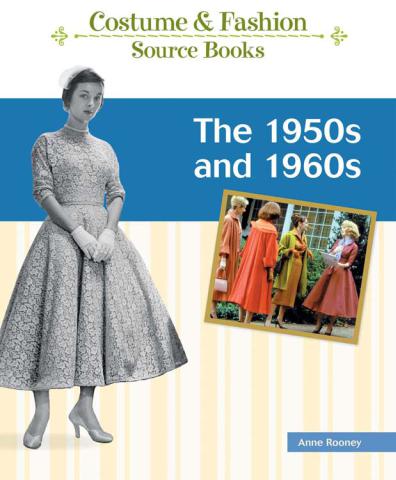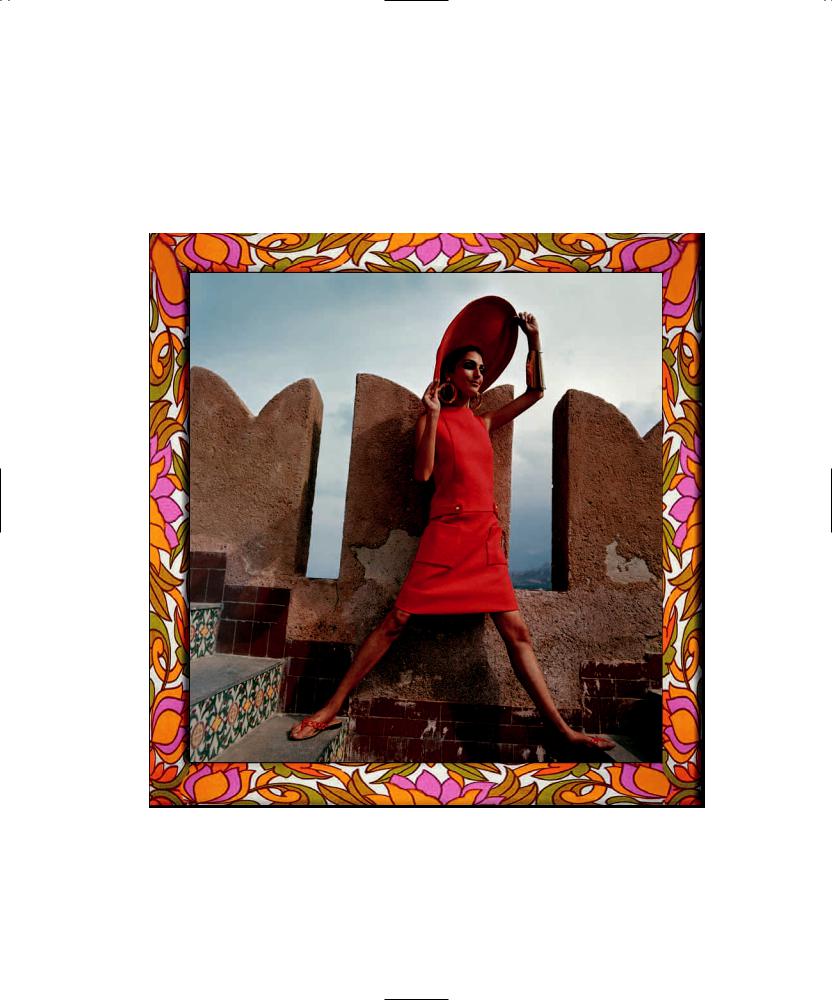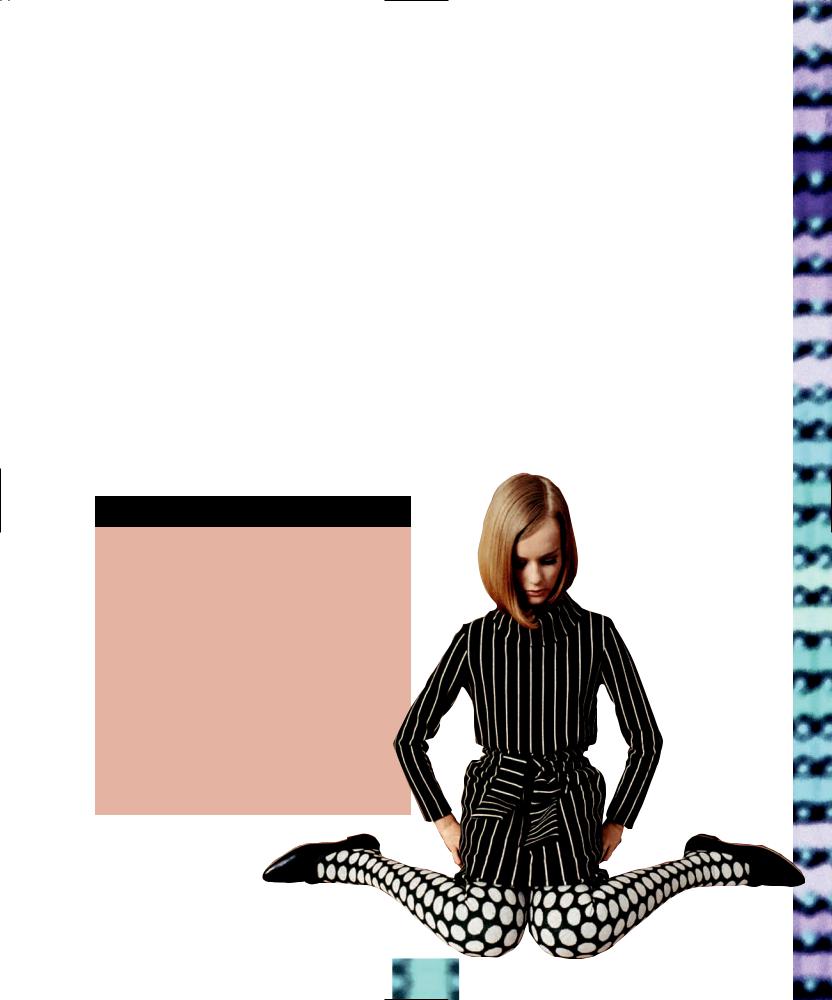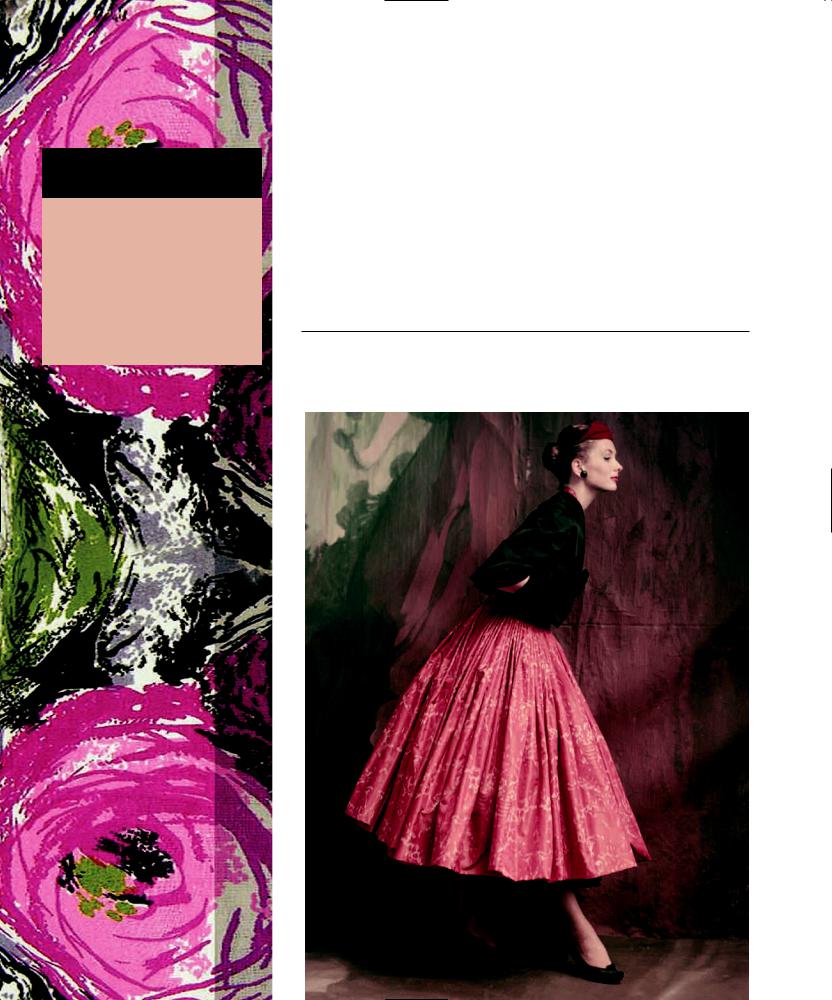
50-60е
.pdf

C O S T U M E A N D F A S H I O N S O U R C E B O O K S
The 1950s and 1960s
Anne Rooney

Copyright © 2009 Bailey Publishing Associates Ltd
Produced for Chelsea House by Bailey Publishing Associates Ltd, 11a Woodlands, Hove BN3 6TJ, England
Project Manager: Patience Coster
Text Designer: Jane Hawkins
Picture Research: Shelley Noronha
Artist: Deirdre Clancy Steer
All rights reserved. No part of this book may be reproduced or utilized in any form or by any means, electronic or mechanical, including photocopying, recording, or by any information storage or retrieval systems, without permission in writing from the publisher. For information contact: Chelsea House, an imprint of Infobase Publishing, 132 West 31st Street, New York, NY 10001.
Library of Congress Cataloging-in-Publication Data
Rooney, Anne.
The 1950s and 1960s / Anne Rooney. p. cm. — (Costume source books)
Includes bibliographical references and index. ISBN 978-1-60413-385-1
1. Fashion—United States—History—20th century—Juvenile literature. 2. Clothing and dress—United States—History—20th century— Juvenile literature. 3. United States—Social life and customs—20th century—Juvenile literature. I. Title. II. Title: Nineteen fifties and sixties. III. Series.
GT615.R66 2009 |
|
391.009'045—dc22 |
2008047260 |
Chelsea House books are available at special discounts when purchased in bulk quantities for businesses, associations, institutions, or sales promotions. Please call our Special Sales Department in New York on (212) 967-8800 or (800) 322-8755. You can find Chelsea House on the World Wide Web at: http://www.chelseahouse.com.
Printed and bound in Hong Kong
10 9 8 7 6 5 4 3 2 1
The publishers would like to thank the following for permission to reproduce their pictures: Bailey Publishing Associates Ltd: contents page; Corbis: 5 (© Condé Nast Archive), 6 (© Condé Nast Archive), 7 (© Bettmann), 8 (© Cat’s Collection), 9 (© Henry Diltz),
13 (© Bettmann), title page and 14 (© Condé Nast Archive), 18 (© Condé Nast Archive), 10 detail and 19 (© Condé Nast Archive), 20 (© Condé Nast Archive), 23 (© Bettmann), 26 (© Jack Moebes), 30 (© Michael Ochs Archives), 32 (© Condé Nast Archive),
33 (© Douglas Kirkland), 35 (© Bettmann), 41 (© Henry Diltz), 42 (© Playboy Archive), 43 (© Condé Nast Archive), 44 (© Corbis), 45 (© Bettmann), 46 (© Güttert/dpa), 47 (© Aladdin Color, Inc./Aladdin Color, Inc.), 52 (© Image Source), 53 (© Bettmann),
54 (© Bettmann), 55 (© Henry Diltz), 5 detail, 38 detail and 56 (© Kate Mitchell/zefa), 59 (© Alan Pappe); Christine Daveau: 22 detail; Mary Evans Picture Library: 50; Lisa Gilbert: imprint and contents pages detail and 32 detail; Kobal Collection: 15, 16, 22, 34 (Paramount), 38 (Danjaq/Eon/UA), 39, 46 detail and 48 (Universal), 51 (20th Century Fox), 58 (New Line/The Kobal Collection/ James, David); Mirrorpix: 28; Rex Features: 12, 40; TopFoto: 11 (Land of Lost Content/HIP), 21 (KPA/HIP), 25 (Le Poer Trench Michael/ArenaPAL), 27 (Topham/UPP), 29 (Land of Lost Content/HIP), 36 (Land of Lost Content/HIP); Topham Picturepoint: 10, 24.

Contents
Introduction |
5 |
Chapter 1: A New Era |
6 |
Chapter 2: Women’s Day Wear |
10 |
Chapter 3: Men’s Day Wear |
22 |
Chapter 4: Women’s Formal and Evening Dress |
32 |
Chapter 5: Men’s Formal and Evening Dress |
38 |
Chapter 6: Time Off—Leisure Wear |
42 |
Chapter 7: Work Wear and Uniforms |
46 |
Chapter 8: Completing the Look |
50 |
Glossary |
60 |
Further Information |
61 |
Source List |
62 |
Index |
64 |


Introduction
In the 1950s and 1960s, fashion magazines were widely available, movies had a mainstream following, and an increasing number of homes were acquiring television sets. More people than ever before could see how the rich and famous dressed. At the same time, cheap, mass-produced clothes began to fill the stores. For the first time, ordinary people could follow fashion and easily align themselves with specific social groups and movements through their choice of clothes.
The 1950s were not very long ago. It’s easy to find photos and movies from the period showing clothes exactly as people wore them. Many older people still remember the time and may even have clothes from the era. Be sure to get right what people wore in any theatrical production or re-enactment.
FA S H I O N V I C T
“ They seek him here, they His clothes are loud, but
It will make or break him so ’Cause he’s a dedicated
Oh yes he is (oh yes he is),
There’s one thing that he
One week he’s in polka-dots,
in stripes.
’Cause he’s a dedicated
Ray Davies, Dedicated
Fashion (1966)
There will be plenty of people around who will say, “It wasn’t like that,” if you get it wrong!
Between 1950 and 1970, there were many different looks, and fashion changed very quickly and dramatically. This book brings together some of the most popular styles and dominant trends and demonstrates how to achieve the look. Some period pieces can still be found in thrift shops and yard sales. Others can be tracked down via the Internet, where there are auction sites that often have vintage pieces selling for low prices. Other items you can make quite simply. During the 1970s, 1980s, and 1990s, there were revivals of 1950s and 1960s fashions, so if you can’t find an original, you can probably find a close copy from a more recent date.
Left: Geometrical patterns in
black and white were
popular in the 1960s.
5

I N S TA N T
W A R D R O B E
“ The most fastidious and fashion-conscious woman can
dress immediately for any occasion in ready-to-wear clothes.”
Vogue magazine, 1951
C H A P T E R 1
A New Era
E M E R G I N G F R O M T H E W A R Y E A R S
During World War II, day-to-day survival was a struggle, and clothing was one of many things in short supply. Fabric and clothing were rationed, and people had to mend and reuse old clothes. Even after the war, clothes rationing continued. But in the 1950s, the fashion scene burst into life, fizzing with color, sensational shapes, and new fibers. It sparked two of the most exciting and fast-moving decades in fashion history, reflecting rapid social change.
Below: In 1953, the American fashion model Suzy Parker was photographed wearing a full skirt and quilted satin jacket. These revolutionary new styles of the post-war years made extravagant use of fabric.

A N E W L O O K F O R A N E W A G E
In 1947, Paris fashion designer Christian Dior launched his revolutionary “New Look” to both searing criticism and rapturous enthusiasm. It was a feminine, sophisticated style with accentuated waists and full skirts. Critics complained that it was unacceptably extravagant to use yards of fabric on a fashion item while some families were so deprived that they could barely feed their children. But after the austerity of the war years, most people wanted to enjoy themselves.
Wearing colorful and flamboyant clothes was one way they could express the postwar spirit of exuberance. It was an enthusiasm that was to last throughout the 1950s and 1960s, producing some of the most exciting and original fashions of the twentieth century.
R E B U I L D I N G T H E W E S T
The 1950s were a boom time in which many people hoped to live the “American Dream.” In the United States, a huge growth in industry caused large, modern factories to spring up across the land. Some of these factories produced clothes and new fabrics. Within a few years of the end of the war, clothes were being mass-produced, and they filled the new department stores. For the first time in history, people other than the very wealthy could afford to own a range of items, not just the few clothes they needed for everyday wear. “Ready-to-wear” collections were launched; a cross between made-to-measure and mass market clothes, they offered a degree of high fashion and exclusivity to people of moderate means.
F A B R I C R E V O L U T I O N
Clothes made from new artificial fabrics such as nylon, Courtelle, polyester, and acrylic became popular in the 1950s and 1960s. Easy to care for, they could be washed in the newly popular electric washing machines and could withstand harsh treatment in spin dryers. Many of them did not even need ironing. Women who couldn’t afford to buy a lot of clothes could make their own (they’d had plenty of practice during the
Above: Women go shopping in a New York department store in 1951. For many people, it was still important to find a bargain and keep clothes as long as possible.
C L O T H F R O M O I L
Unlike wool, cotton, silk, and linen, artificial fibers are not made from plant or animal material. Instead, they are made in factories from chemicals derived from oil. The first such fabric was nylon, invented in 1935 and used for stockings from 1940. The first polyester fiber, Terylene, was invented in 1941. When polyester clothes were first sold in the United States, in 1951, the advertisements called polyester a “miracle” fiber that could be worn for 68 days without ironing and still look presentable!
7

S PA C E A G E
“ Space projections . . . plastic, chrome, Dynel . . .
everything silver, from visor to stockings and shoes.”
A 1966 issue of Vogue magazine describes
the growing trend in space-age fashion
war years). Sewing machines and knitting machines quickly became popular. All a woman needed to keep up with the latest trends was some fabric, a paper pattern, and a sewing machine.
I N T O T H E S P A C E A G E
The spirit of optimism grew throughout the 1950s and into the 1960s. The launch of the first satellite in 1957 and the first man in space in 1961 sparked public enthusiasm for technology and started the “space race.” The USSR had been the first country to send a man into space, but the U.S. was determined to be first to put a man on the moon. In the 1960s, the obsession with all things space-related touched many aspects of daily life, including fashion. The fabrics used for clothing became more outlandish and experimental—plastics, paper, and metal featured in clothes that were often impractical and sometimes barely wearable. Science-fiction movies and television shows such as Star Trek, Lost in Space, 2001: A Space Odyssey, and
Barbarella showed tight jumpsuits and shiny, metallic fabrics that were soon copied in real life.
L I B E R A T I O N
The 1960s were marked, too, by social revolution. The invention of the contraceptive pill put women in charge of their sexual life for the first time by allowing them to control their fertility. Taking strides into public life and toward social equality, they chose clothes that suited a more liberated lifestyle. Many women rebelled against conventional attitudes by ditching skirts and wearing pants that gave them greater freedom of movement. The Civil Rights Act of 1964 meant that black people began to move toward equality with white people in the United States. The styles and attitudes of black activists, actors, and musicians began to have an impact on white culture, including fashion.
Both women and men began to challenge the rigid gender roles that held sway in the 1950s. It gradually became more acceptable to be homosexual, get divorced, and enjoy sex outside of marriage. Late in the 1960s, men adopted more
Left: This fantasy costume from the film Barbarella
(1968) shows actor Jane Fonda in popular space-
age styling.
8

flamboyant fabrics, colors, and styles that would have been considered dangerously effeminate in the previous decade. They wore figure-hugging clothes, flounces, frills, bright colors, and patterns not seen in men’s costume since the eighteenth century.
A N O T H E R R E V O L U T I O N
In the later 1960s, the spirit of optimism gave way to disenchantment. A long-running war in Vietnam, together with the Cold War and the
nuclear arms race, contributed to disillusionment with the modern world. Fashion became nostalgic, taking its cue from the early twentieth century and featuring long, flowing skirts, frills, and flounces. Hippies found inspiration in Eastern philosophies, particularly from India, and swapped garish fluorescents and metallics for ethnic clothes made from natural fabrics and colored with vegetable dyes. Artificial fibers gave way to cotton, linen, hemp, and wool as young people became cynical of big business, technology, and the status quo.
FA S H I O N A N D
E Q U A L I T Y
“ There was a time when clothes were a sure sign of a woman’s social position and income group. Not now. Snobbery has gone out of fashion, and in our shops you will find duchesses jostling with typists to buy the same dress.”
British fashion designer Mary
Quant, speaking in 1966
S T Y L E T I P
In the 1960s, a person’s political beliefs could often be read from his or her clothes. This makes the clothing chosen for a play or re-enactment particularly important. The students who rioted in Paris often wore the “beatnik” style of black, while American protesters against the Vietnam War might wear flamboyant and flowery hippie or “romantic” clothing. So remember to match your costume appropriately if you are staging one of these events.
Left: In the 1960s, people who rejected mainstream values often showed their different stance in their choice of “rebellious” clothing.
9
